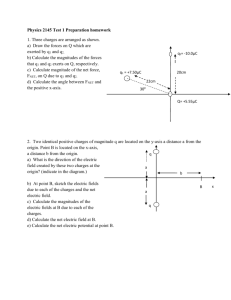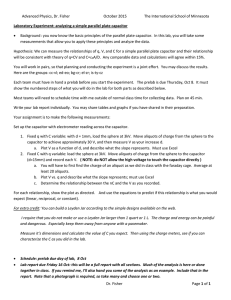Document 10388191
advertisement
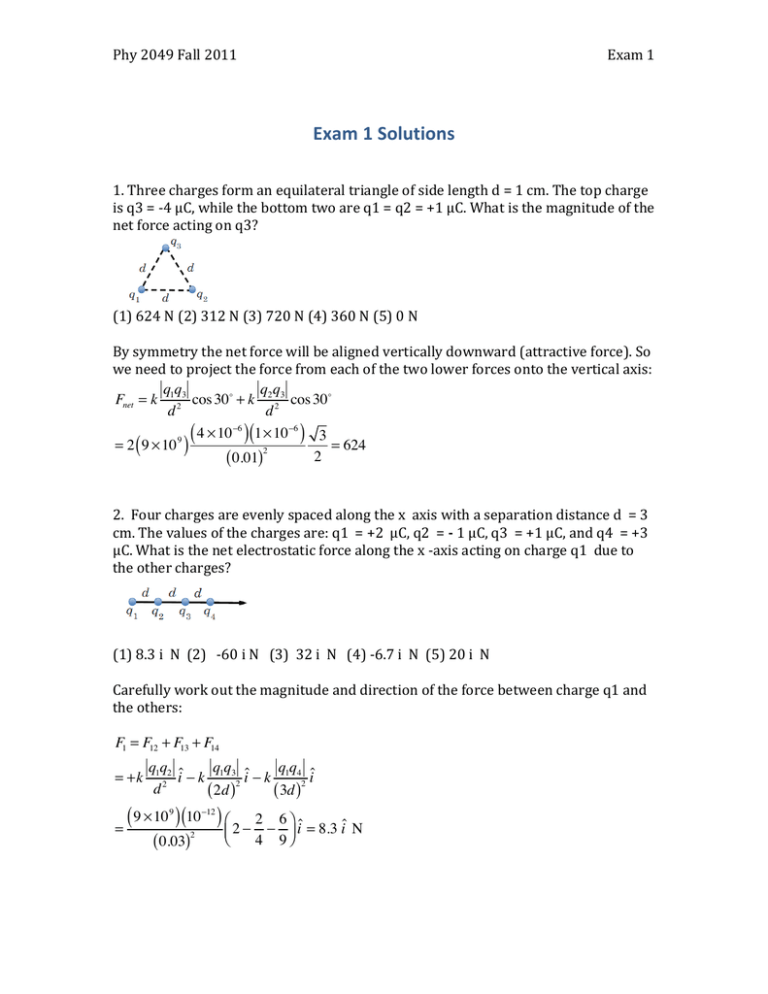
Phy 2049 Fall 2011 Exam 1 Exam 1 Solutions 1. Three charges form an equilateral triangle of side length d = 1 cm. The top charge is q3 = -­‐4 μC, while the bottom two are q1 = q2 = +1 μC. What is the magnitude of the net force acting on q3? (1) 624 N (2) 312 N (3) 720 N (4) 360 N (5) 0 N By symmetry the net force will be aligned vertically downward (attractive force). So we need to project the force from each of the two lower forces onto the vertical axis: qq qq Fnet = k 1 2 3 cos 30! + k 2 2 3 cos 30! d d "6 4 ! 10 ) (1! 10 "6 ) 3 9 ( = 2 ( 9 ! 10 ) = 624 2 ( 0.01)2 2. Four charges are evenly spaced along the x axis with a separation distance d = 3 cm. The values of the charges are: q1 = +2 μC, q2 = -­‐ 1 μC, q3 = +1 μC, and q4 = +3 μC. What is the net electrostatic force along the x -­‐axis acting on charge q1 due to the other charges? (1) 8.3 i N (2) -­‐60 i N (3) 32 i N (4) -­‐6.7 i N (5) 20 i N Carefully work out the magnitude and direction of the force between charge q1 and the others: F1 = F12 + F13 + F14 = +k q1q2 ˆ qq qq i ! k 1 32 iˆ ! k 1 42 iˆ 2 d ( 2d ) ( 3d ) ( 9 " 10 )(10 ) # 2 ! 2 ! 6 & iˆ = 8.3 iˆ N = 9 ( 0.03)2 !12 %$ 4 ( 9' Phy 2049 Fall 2011 Exam 1 3. Two charged particles are fixed to the x -­‐axis: particle 1 of charge q1 = 20μC at x = 0.2 m, and particle 2 of charge q2 = -­‐ 80 μC at x = 0.8 m. At what coordinate along the x axis is the net electric field produced by the particles equal to zero? (1) -­‐0.4 m (2) 0.4 m (3) 1.4 m (4) 2 m (5) -­‐0.8 m x 0.8 0.2 The above diagram shows the direction and approximate magnitude of the electric field contribution from each charge. Given the relative strengths, the only place where the field can go to zero is to the left of x=0.2. q1 q2 Ex = !k =0 2 +k ( 0.2 ! x ) ( 0.8 ! x )2 " q2 = q1 ( 0.8 ! x )2 ( 0.2 ! x )2 0.8 ! x 0.2 ! x " x = !0.4 4. Two charges are separated by a distance d = 1 m along the y -­‐axis, bisected by the x -­‐axis. The upper charge has q1 = +2 x 10-­‐9 C and the lower charge has q2 = -­‐ 3 x 10-­‐9 C. At position P along the x -­‐axis, which is equidistant from each charge by distance d , what is the y component of the net electric field? (1) -­‐22.5 N/C (2) -­‐45 N/C (3) -­‐7.8 N/C (4) 4.5 N/C (5) 27 N/C " ±2 = Phy 2049 Fall 2011 Exam 1 The diagram shows the direction of the electric field contribution from each charge. The y-­‐component of the field from each charge is: q E1y = !k 12 sin 30! d q E2 y = !k 22 sin 30! d k Ey = E1y + E2 y = ! 2 ( q1 + q2 ) = !22.5 2d 5. A glass rod forms a semi-­‐circle of radius r = 5 cm with a charge of +q distributed uniformly along the upper quadrant and -­‐q distributed along the lower quadrant, where q = 5 pC. What is the magnitude and the direction (as the polar angle relative to the direction of the x -­‐axis) of the electric field at the center P of the semi-­‐circle. (1) 23 N/C, θ = 270° (2) 36 N/C, θ = 180° (3) 0 N/C (4) 23 N/C, θ = 0° (5) 36 N/C, θ = 90° The diagram shows the direction of the electric field contribution from each quadrant. By symmetry, the net field points down in the ! ĵ direction, which is ! = 270! The magnitude (not really needed to choose the correct answer!) is given by: Phy 2049 Fall 2011 Exam 1 q " R 2 dq = ! ds = ! Rd# " " dq ! Rd# Ey+ q = $ % k 2 sin # = $ % k sin # " /2 R " /2 R2 ! ! = +k cos# |"" /2 = $k R R ! 4k q & Eytot = $2k = $ = $23 R " R2 6. An electron is released from rest from the surface of a large non-­‐conducting plate. The surface charge density of the plate is σ= -­‐4 μC/m2. Once released, what is the velocity of the electron when it reaches a distance 0.3 cm away from the plate? You may ignore gravity. The magnitude of the electric field from the surface of a large non-­‐conducting sheet ! is E = 2" 0 Since the sheet is negatively charged, the electron will be accelerated away from it: ma = F = eE != eE me From kinematics, we can find: v 2f ! vi2 = 2ad a= v 2f = 2eEd 2e" d = me 2 # 0 me v f = 1.54 $ 10 7 m/s 7. A copper wire with a resistivity of ! = 1.7 " 10 #8 $m has a circular cross section of radius r = 0.05 cm and a length L = 1 m initially. It is stretched to a length of 3 m while maintaining a constant volume. What is the new total resistance of the stretched wire? Hint: the radius changes. (1) 0.20Ω (2) 0.022 Ω (3) 0.065 Ω (4) 0.0024 Ω (5) 9 Ω Phy 2049 Fall 2011 Exam 1 V1 = ! r12 L1 = V2 = ! r22 L2 = ! r22 3L1 1 " r12 = 3r22 " r2 = r1 3 L 3L 3L L " R2 = # 2 = # 21 = # 2 1 = 9 # 12 A2 ! r2 ! r1 / 3 ! r1 " R2 = 0.20$ 8. A light bulb with a tungsten wire filament of resistivity ! = 5.25 " 10 #8 $m is connected to an EMF source that maintains a potential difference of 120 V. If the light bulb is designed to dissipate 60 W in light and heat, what is the necessary resistance of the filament? (1) 240 Ω (2) 120 Ω (3) 60 Ω (4) 2 Ω (5) 5.25x10-­‐8 Ω We actually do not need to know the resistivity: !2 P = 60 W = R 2 ! 120 #120 "R= = = 240$ P 60 9. In the circuit shown, ε1 = ε2 = 10 V and R1 = R2 = R3 = 10 Ω. What is the magnitude of the current flowing through the middle resistor labeled R1? (1) 0.67 A (2) 0.33 A (3) 0.5 A (4) 2 A (5) 0 i i i1 i1 Phy 2049 Fall 2011 Exam 1 By symmetry, we have from the junction rule: 2i = i1 then by the loop rule (left or right loop): ! " iR2 " i1 R1 = 0 i ! " 1 R2 " i1 R1 = 0 2 ! 10 2 # i1 = = = A ( R1 + R2 / 2 ) 15 3 10. The diagram shows a network of resistors connected to an EMF source ε1 . If all resistors have the same resistance R , what is the equivalent resistance Req of the circuit connected to ε1 ? (1) 12R=13 (2) 12R=7 (3) 2R=9 (4) 2R (5) 8R The 2 resistors at the bottom left (7, 8) are in parallel and have resistance R/2. That is in series with 2 more (1, 2) for resistance 5R/2. That in turn is in parallel with one (6) for resistance 5R/7. That is in series with one resistor (3) for 12R/7. That covers the left side of the EMF. All that is in parallel with 2 resistors in series (4, 5) with resistance 2R, giving an overall equivalent resistance of : 1 7 1 13 = + = Req 12R 2R 12R 12R ! Req = 13 Phy 2049 Fall 2011 Exam 1 11. A 10 μF capacitor with an initial potential difference of 12 V is discharged through a resistor when a switch between is closed at t = 0. At t = 2 s the potential difference across the capacitor is 4 V. What is the resistance of the resistor? (1) 180 kΩ (2) 145 kΩ (3) 490 kΩ (4) 67 kΩ (5) 90 kΩ For a capacitor that is discharging in an RC circuit, we have: q ( t ) = q0 e!t /RC " V ( t ) = V0 e!t /RC since q = CV V ( 0 ) 12 e = = !2/RC = e2/RC V (t ) 4 e 0 " ln ( 3) = R= 2 RC 2 = 180k# C ln ( 3) ˆ ˆ ˆ 12. The flux of the electric field (24 N/C)i + (30 N/C) j + (16 N/C)k through a 2.0 m2 portion of the yz plane is: (1) 48 N m2 /C (2) 34 Nm2 /C (3) 42 Nm2 /C (4) 32 Nm2 /C (5) 60 Nm2 /C S: Area A = (2m 2 )iˆ. Electric flux Φ = E ⋅ A = 24 × 2 = 48N ⋅ m2 / C. 13. Charge Q is distributed uniformly throughout an insulating sphere of radius R. The magnitude of the electric field at a point R/4 from the center is: S: Make a gauss surface of radius r=R/4 and use gauss’ law 2 E ∫ ⋅ dA = 4πr E 4π 3 4π 3 r r ρ ; Q == R ρ ⇒ qenc = Q( ) 3 3 3 R 1 Q r Q E= q = ⋅ = 2 enc 2 4πε 0 r 4πε 0 R R 16πε 0 R 2 qenc = Phy 2049 Fall 2011 Exam 1 14. A round wastepaper basket with a 0.15-m radius opening is in a uniform electric field of 300 N/C, perpendicular to the opening. The total flux through the sides and bottom, in N ⋅ m2/C, is: (1) 21 (2) 4.2 (3) 0 (4) 280 (5) can't tell without knowing the areas of the sides and bottom S: There are no charges in the basket because of uniform electric field. Gauss’ law gives E ⋅ d A + E ∫ ∫ ⋅ dA = 0 s +b Φ= o ∫ s +b E ⋅ dA = − ∫ E ⋅ dA = E ⋅ πr 2 = 300 × π × (0.15) 2 = 21N ⋅ m 2 / C o 15. Eight identical spherical raindrops each have a potential V on their surface, relative to the potential far away. They coalesce to make one spherical charged raindrop whose surface potential is: (1) 4V (2) V=2 (3) 2V (4) V=8 (5) 8V S: Initial spherical raindrop has radius R, charge q and surface potential V. Final large raindrop has radius 2R, charge 8q and surface potential Vf. For spherical symmetry charge distribution, the surface potential is q V= . 4πε 0 R Therefore (8q) Vf = = 4V 4πε 0 (2 R) 16. Two particle with charges Q and Q are fixed at the vertices of an equilateral triangle with sides of length a. If k = 1/4πε0, the work required to move a particle with a charge q from the other vertex to the center of the line joining the fixed charges is: (1) 2kQq/a (2) kQq/a (3) kQq/a2 (4) 0 (5) √2kQq=a Phy 2049 Fall 2011 Exam 1 S: Work required is equal to the change of potential energy kQ kQ 2kqQ W = ΔU = q(V f − Vi ) = q[2( − )] = (a / 2) a a 17. An electron goes from one equipotential surface to another along one of the four paths shown below. Rank the paths according to the work done by the electric field, from least to greatest. (1) 4 and 2 tie, then 3, then 1 (2) 4, 3, 2, 1 (3) 1, 3, 4 and 2 tie (4) 1, 2, 3, 4 (5) 4, 3, 1, 2 S: Work done by the electric field is equal to minus the change of potential energy: W = !q"V = +e"V Electron has negative charge (-e). Therefore the works done are +30e, +10e, +20e +10e for paths 1,2,3,4 respectively. 18. The plate areas and plate separations of five parallel plate capacitors are capacitor 1: area A0, separation d0 capacitor 2: area 2A0, separation 2d0 capacitor 3: area 2A0, separation d0/2 capacitor 4: area A0/2, separation 2d0 capacitor 5: area A0, separation d0/2 Rank these according to their capacitances, least to greatest. (1) 4, 1 and 2 tie, then 5, 3 (2) 5, 4, 3, 2, 1 (3) 5, 3 and 4 tie, then 1, 2 (4) 1, 2, 3, 4, 5 (5) 3, 5, 1 and 2 tie, then 1, 4 Phy 2049 Fall 2011 Exam 1 S: The capacitances for parallel plate capacitors is ε0A/d. Hence the capacitances are ε0A/d, ε0A/d, 4ε0A/d, ε0A/4d, 2ε0A/d for capacitors 1, 2, 3, 4, 5 respectively. 19. A 20 V battery is connected across capacitors of capacitances C1 = 4 µF, C2 =10 µF and C3 =6 µF as in the figure. Find the charge on capacitor C3 in µC. (1) 24 (2) 60 (3) 80 (4) 36 (5) 48 S: C2 and C3 are connected in parallel, C23= C2+ C3=16µF. C23 and C1 are connected in series, Ceq=(16/5) µF. Qeq=CeqV=64µC. Qeq 64 Q V1 = 1 = = = 16V C1 C1 4 V3 = V2 = V − V1 = 20 − 16 = 4V Q3 = C 3V3 = 6 × 4 = 24 µC 20. An air-filled parallel-plate capacitor has a capacitance of 2 pF. The plate separation is then doubled and a wax dielectric is inserted, completely filling the space between the plates. As a result, the capacitance becomes 4 pF. The dielectric constant of the wax is: (1) 4.0 (2) 0.5 (3) 2.0 (4) 0.25 (5) 8.0 S: Air-filled parallel-plate capacitor has area A and plate separation d. ε0 A = 2 pF d ε A 2 pF κ 0 = 4 pF ⇒ κ ⋅ = 4 pF ⇒ κ = 4 2d 2

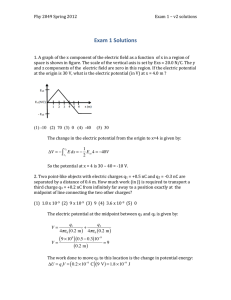
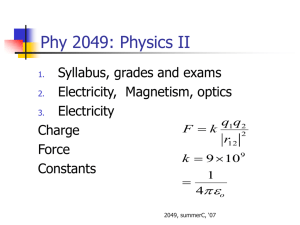
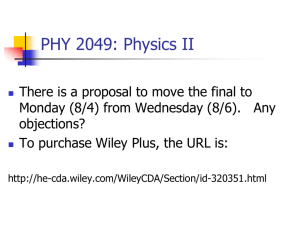
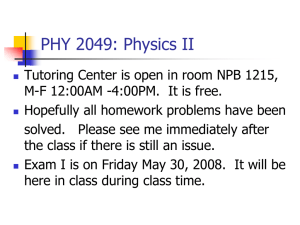
![Sample_hold[1]](http://s2.studylib.net/store/data/005360237_1-66a09447be9ffd6ace4f3f67c2fef5c7-300x300.png)
